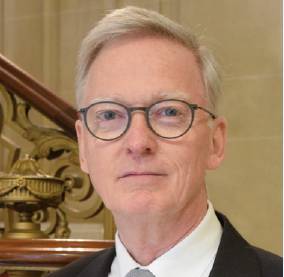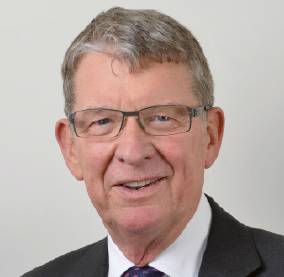Message from RAeS
Message from RAeS
 Since the Society’s first transition to virtual events back in September last year, in response to the Covid pandemic, I have been very impressed by the large number of high-quality events now being organised online by our Branches, Divisions and Specialist Groups.
Since the Society’s first transition to virtual events back in September last year, in response to the Covid pandemic, I have been very impressed by the large number of high-quality events now being organised online by our Branches, Divisions and Specialist Groups.
I was very pleased to be able to join the Washington Branch online pre-AGM event on 21 June at which Jim Bridenstine, former NASA Administrator, was the invited speaker. He praised the move to the new apolitical bipartisan approach to decision-making on NASA’s programmes and the increasing drive towards commercialisation. He specifically mentioned the current innovative programmes, not only the Moon Gateway in partnership with other nations and the current Mars exploration exploiting a helicopter but also NASA’s interest both in urban air mobility and supersonic aircraft. It was particularly encouraging to see Mr Bridenstine’s continuing interest in the Society, since his attendance at the Society’s Farnborough Summer Reception held at No.4 Hamilton Place, in June 2018.
On 5 July, I chaired the Aerodynamics Specialist Group’s 2020 Lanchester Lecture, delayed to this year owing to the Covid situation. The lecture is held in honour of Frederick William Lanchester, Honorary Fellow of the Royal Aeronautical Society and renowned for his contribution to the world of scientific aeronautics. The speaker on this occasion was Trevor Birch, Technical Fellow at DSTL who spoke of the many aerodynamics challenges associated with internal and external weapons integration on aircraft and the impact on both aircraft and weapon design and performance.
On 8 July, I chaired the Women in Aerospace & Aviation Committee’s Amy Johnson Lecture, held in honour of her admirable aviation achievements. The invited speaker was Air Commodore Suraya Marshall, Commandant at the Royal Air Force College Cranwell, who gave an inspirational talk covering many topics, including the new leadership approach introduced by the RAF to attract and retain women at all levels. Also explaining her personal journey, the feedback from the online audience was extremely positive. (Watch the lecture video here: https://www.youtube.com/watch?v=CQrzYLckA3Y)
Concerning the Society’s aim to provide independent advice to government, the Society prepared a response to the call by the House of Commons Science and Technology Select Committee for written evidence regarding the UK space strategy and UK satellite infrastructure inquiry, duly submitted on 1 July.
The MoD’s Defence and Security Accelerator (DASA), launched its ‘Space to Innovate Campaign’ with the objective to release a series of challenge ‘drops’ to find and fund solutions to major space hurdles, with up to £2m in funding available over the next two years, launched on 16 June which seeks proposals for ‘novel and innovative future space technologies’, both to ‘develop visualisation tools to observe objects in orbit’, and to ‘define methods for characterising objects in space and their intent’.
The emphasis on the challenges of space debris have been raised at Westminster and by the UK Space Agency which shows the need for a clear over-arching UK Space Strategy addressing UK’s objectives in a civil and defence context, addressing the allocation of roles and responsibilities between the various government and military bodies, and the valued contributions of both industry and academia.
On a somewhat lighter note, many of us watched the live transmission of Virgin Galactic’s successful launch of its founder Sir Richard Branson and five other crew members into suborbital space, reaching a height of around 50 miles for a few minutes on 11 July in a milestone mission that marked the first fully-crewed flight of its VSS Unity space plane and the safe return to Spaceport America in New Mexico. The vehicle was piloted by David Mackay, Virgin Galactic Chief Pilot and former RAF Harrier test pilot. Already the first native-born Scot to visit space, he delivered the 108th Wilbur and Orville Wright Lecture at No.4 Hamilton Place in December 2019.
With more than 1,600 people already signed up for future flights, Branson’s plan is to provide up to 400 flights per year from each of the future spaceports capable of supporting such flights. Our readers may however recall that at the June meeting, Council members exchanged views on state/private funded human space travel and the value for the public good, as well as the associated ethical and moral risks, topics which will remain on the Society agenda.
In conclusion, I wish to thank you all for your continuing dedication to the Society, whether you are Corporate Partners, whether you are involved in management and functioning of our Branches, Divisions, Specialists Groups, Committees or Boards, whether you are part of our very effective Executive Team, or simply Society members across all grades. I wish you all an enjoyable, safe and healthy break.
Sir Brian Burridge
 - Despite global uncertainty on the progress of Covid, airline passenger numbers are beginning to creep-up in Europe and the US. European traffic has reached 63% of 2019 levels and, in the US, domestic leisure travel has reached 90% but business travel has settled at just 20% of the 2019 figure with little immediate optimism over further recovery. At the end of 2020, the world’s major airlines were holding over $400bn of debt. With rising Covid-19 cases in India and Latin America, further losses of $90bn are predicted in 2021 (see International Airlines suffering from ‘long Covid’.
- Despite global uncertainty on the progress of Covid, airline passenger numbers are beginning to creep-up in Europe and the US. European traffic has reached 63% of 2019 levels and, in the US, domestic leisure travel has reached 90% but business travel has settled at just 20% of the 2019 figure with little immediate optimism over further recovery. At the end of 2020, the world’s major airlines were holding over $400bn of debt. With rising Covid-19 cases in India and Latin America, further losses of $90bn are predicted in 2021 (see International Airlines suffering from ‘long Covid’.
- Meanwhile, the climate change challenge is at the top of the aviation agenda for governments with the European Commission’s proposal for new legislation covering targets for sustainable aviation fuel usage, a fuel tax on flights within Europe and a tightening-up of the European Emissions Trading Scheme, an unwelcome move with IATA given the current Covid situation. More positively, the UK has launched the Zero Emission Flight Infrastructure competition aimed at supporting the infrastructure for electric and hydrogen aircraft.
- With the help of the Space Specialist Group (chaired by our President), we have submitted some very thoughtful evidence to an inquiry into space by the House of Commons Science and Technology Committee. Our evidence has not yet been published but two key areas for us are the need for the UK to significantly increase investment in space if we are to put ourselves alongside other key space nations around the world, and to recognise the need to have sovereign UK space capability alongside international collaboration, especially through the European Space Agency (ESA). It was also good to see the opening of the new National Space Propulsion Test Facility which is one of only three in the world able to test state-of-the-art propulsion engines for small satellites.
- The Young Persons Committee hosted their second AeroTube video competition and have seen some great entries from the UK and around the world. The Young Persons Committee would like to thank all those who participated and submitted entries! Congratulations to our winner Alex Yiannakou for his video ‘Voyager: Mankind’s Greatest Expedition’, looking at NASA’s Voyager Mission: also to our runner-up Lisa McNamee for her video ‘What is an Analogue Space Mission?’ These competition entries can be found to view on the Royal Aeronautical Society YouTube channel.
- On Sunday the 25 July the Coventry Branch celebrated its 95th anniversary. The Coventry Branch was the first to be formed under rules for the formation of Branches issues by Council in 1926. The 61st Annual Report of Council 1925-26 states: “The formation of Branches will greatly stimulate interest in aeronautics and will considerably widen the scope of the Society’s activities.” Congratulations to the Coventry Branch – first amongst equals. To give you a feel for the times, the day before, two Lufthansa Junkers aircraft had left Berlin bound for Beijing on a return trip to be completed on 26 September.
- In September the Society is pleased to be hosting the 2021 European Rotorcraft Forum which is one of the premier events in the rotorcraft community’s calendar. It brings together the entire ecosystem from manufacturers, through to regulators to discuss advances in all aspects of the life cycle from research to rotorcraft operation. This Forum will be the 47th in a series of events, which take place annually across Europe, rotating around the United Kingdom, Germany, France, Italy, the Netherlands, Russia and Poland. The first ERF was held here in Southampton in 1975. The Forum will take place virtually on 7-9 September 2021. Join us online from wherever you are in the world for plenary and technical sessions on areas such as aerodynamics, flight test, flight mechanics, eVTOL/ AAM, aircraft design, manufacturing and much more (see Capability revolution).
- Congratulations to Professor Jonathan Cooper FRAeS who has taken up the role as the Aeronautics Branch Chair within CEAS, the Council of European Aerospace Societies. Jonathan’s appointment will maintain the strong links the Society has with its European counterparts, and we will continue to work closely with other European bodies and agencies to further promote aeronautics research and development.
- Finally, we mark a great achievement in gaining OFQUAL recognition as an apprenticeship endpoint assessment organisation. As a regulator with statutory powers, OFQUAL will in future provide External Quality Assurance of our activity. Many congratulations are due to Ros Azouzi and her team for surmounting this significant hurdle. Congratulations also go to our Editor-in-Chief, Tim Robinson, for winning the 2021 Aerospace Media Award for best commercial aviation submission with his article Airbus spearheads zero-carbon Moonshot (AEROSPACE, November 2020). Tim was up against some stiff competition with finalists from Aviation Week and Flight International which, building on the team’s two awards from last year, is testament to the quality of AEROSPACE.